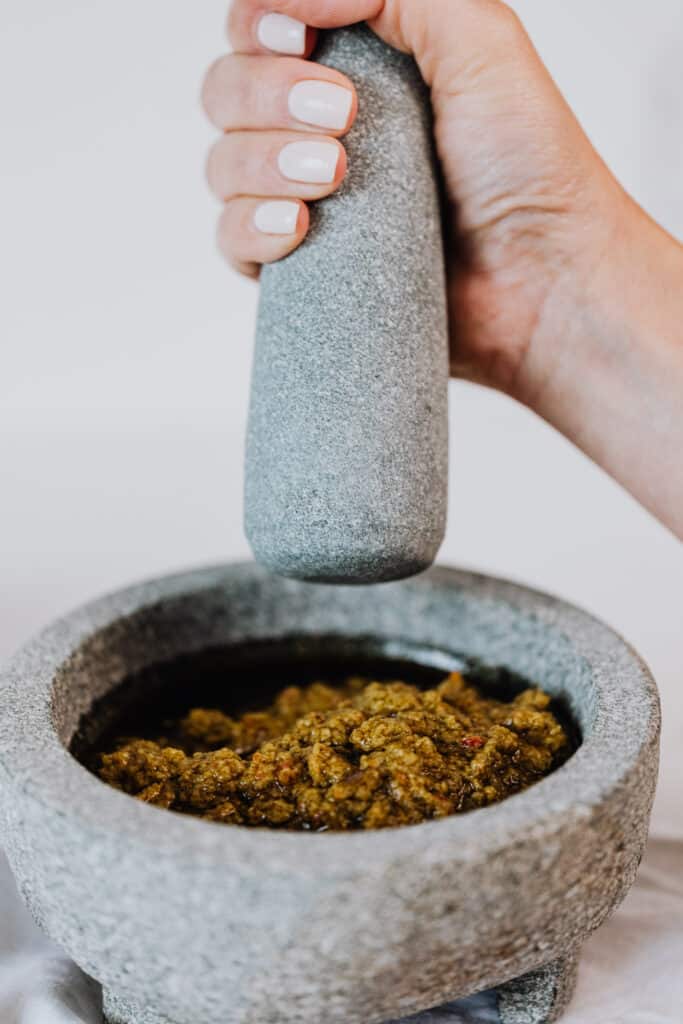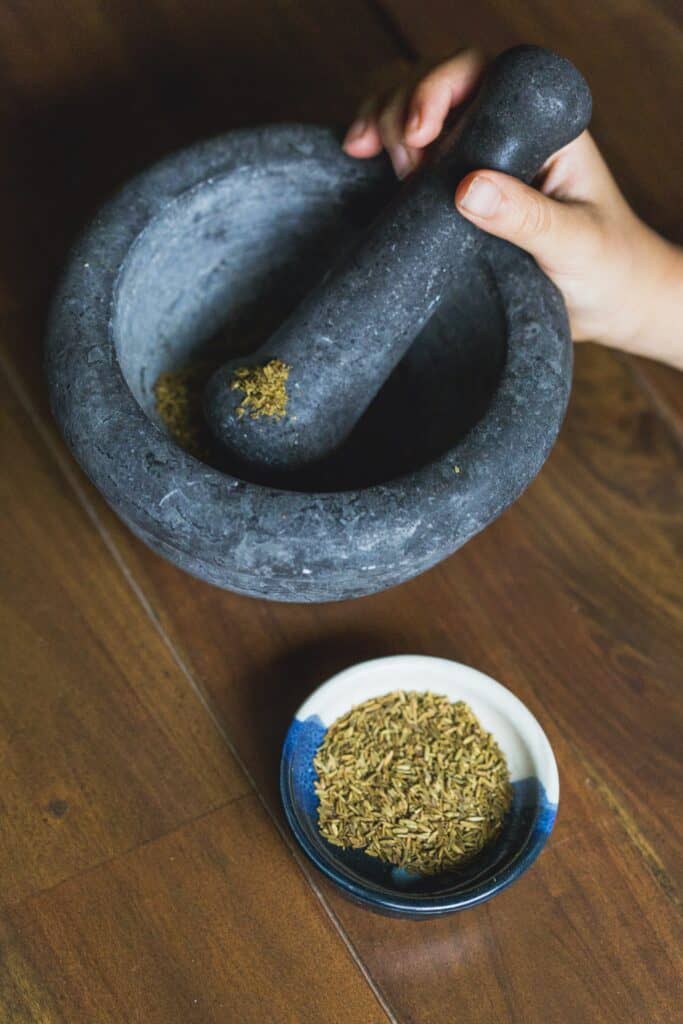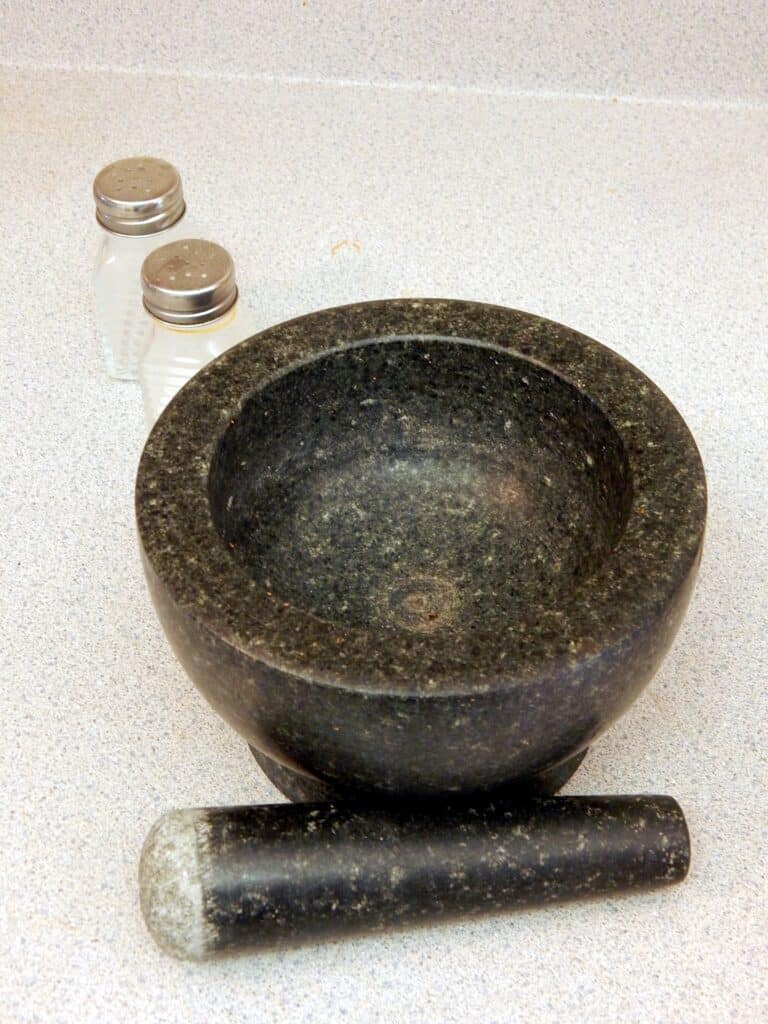As an Amazon Associate we earn from qualifying purchases.
Right up there with fire (and maybe even before that), the mortar and pestle was one of the first kitchen gadgets man invented. After all, what is a mortar and pestle than two rocks bashing and grinding into each other? Here in San Diego, you can even see ancient mortars carved into the rocks at historic sites.
Without the mortar and pestle there would probably be no bread or pesto, two of my favorite things. That said, even though your prehistoric ancestors didn’t clean their mortar and pestles doesn’t mean you don’t have to. In today’s article I’ll review how to clean different types of mortar and pestles.
Quick Navigation
How to Clean a Mortar and Pestle
To clear a mortar and pestle, it’s a simple 4 step process with a 5th step that you only need to do every couple of months.

Step 1: Rinse Everything With Water
The first step is to get out as much of whatever you just ground as possible. This is going to fall into two things:
- Water-soluble, such as fruit juices
- Non-water soluble, such as garlic and oils
To maximize the efficiency of this step, use hot water. It doesn’t have to be boiling hot, but you want more than warm water when doing this.
Step 2: Add Rice or Another Generic Flavorless Medium
Once the old food has been removed, put in some dry rice. I will be using the neutral white rice as the abrasive sponge. I recommend filling your mortar about halfway full.
Step 3: Grind to a Powder
Basically just apply elbow grease and time. While you are grinding down the rice it is acting both as an abrasive to ensure that food is scraped off but also as a desiccant and sponge to remove any liquids and grease from the mortar and pestle.
Step 4: Dump the Powder and Rinse
Dump the powder (might be a paste depending on what was in your bowl). Use hot water again as you will want to make sure all food particles are removed from the bowl.
From here, let your mortar and pestle air dry. Afterward, make sure to store your mortar and pestle in a large kitchen cabinet to avoid cracking or chipping the bowl. If you don’t have enough space, it’s possible to set up a storage area similar to how a DIY gun cabinet is built.
Step 5: Apply Mineral Oil (Wood Ones Only)
If your mortar and pestle are made of wood you may want to consider seasoning it with mineral oil. Make sure it is food grade mineral oil, as it has no taste and is safe for human consumption.
It is important to season wooden cookware at least a couple of times a year or whenever the wood is getting dry. This will prevent warping and cracking due to water loss.

Can I Use Olive Oil if I Don’t Have Mineral Oil?
This applies to wooden mortars and pestles only, and while you conceivably could use any food grade oil, you will want to keep a couple things in mind:
- Not all oils are flavorless, so don’t pick something you wouldn’t want potentially mixing with your next grind.
- Different oils have different shelf lives before going rancid. Yes, oil goes bad and it is bad for you when it does. For example, flaxseed oil is notorious for going rancid at room temperature and while it is totally edible, this would make for a horrible seasoning oil. If you are investing in wood-based cookware, I highly recommend picking up food-grade mineral oil.
Also keep in mind butchers block conditioner is not the same thing, as it often has additional additives in it like wax.
Types of Mortar and Pestles to Clean
Mortar and pestles come in all sorts of materials nowadays, from stones like marble and granite to glass, ceramics, and even wood. In general the steps for cleaning them all pretty similar. The areas you need to watch out for are wood needing mineral oil every so often to keep it moist.
Porous materials like stone and wood leach oil and water from your grinds as well as soap if you try to add soap to the dish. Brittle materials like glass, ceramic, and porcelain need a gentler touch (real minimal smashing, more of a push).
- Stone: Stone like marble, granite, and volcanic rock (molcajetes) are porous. This means there are small holes for air, water, oil, or even food to get stuck in. To get food out you will need a combination of hot water to liquify leftovers as well as the white rice grind to clean out and absorb anything.
- Glass, porcelain, and ceramics: Never smash in glass (I know that should be obvious), but just because you see people pounding away at a stone mortar doesn’t mean you should do it with your glass one. The last thing you want is a shard of glass in your hand and flakes of glass in your food. If you need to “press” something, do it gently and controlled. Luckily, glass is barely porous so the risk of food seeping into the mortar is very low.
- Metal: Metal is not porous at all but it does respond quite a bit to being heated and cooled. Avoid rapid temperature changes so it doesn’t warp.
- Wood: Wood mortars and pestles are some of the best looking ones but are also maybe the most finicky. Wood is both porous and frail, so you are going to be limited in what you can do as well as needing to condition your tools more frequently and with oil.

Seasoning Mortars and Pestles Before the First Use
If you are buying a stone mortar and pestle you will need to season it prior to using it. This is because there are small pieces of rock and or sand still in the mortar and on the pestle.
Additionally, because the mortar and pestle have not been used before, you need to grind down the edges of the mortar and pestle as well. To do this, you just need to find literally anything hard to grind that you don’t mind tossing.
White rice is still the big recommendation here as it is both hard and really cheap. Grind the white rice into powder then dump it. Add a bit more water and then rinse everything out.
Is Cleaning Your Mortar and Pestle the Same Thing as Seasoning It?
No, seasoning a mortar and pestle is going to get it ready to use by prepping the grinding plane. Cleaning your mortar and pestle is going to remove food pieces and debris.
While both steps may involve grinding a neutral medium like rice, cleaning your mortar and pestle will have many more steps in terms of water, rinsing, and drying.
If your mortar and pestle are made of wood don’t forget seasoning with mineral oil is also important to keep the wood from drying out.
Conclusion
A mortar and pestle can be a great addition to your kitchen toolset. If you are looking to get the best spices and emulsions possible, a mortar and pestle is really the only way to do it. What you don’t want however is left off bits of food, stone, or germs getting into the mix (pun intended).
Make sure you clean your mortar and pestle regularly after use, avoid soap on porous materials, and never put them in the dishwasher. When in doubt rice, water, and grind it out.
